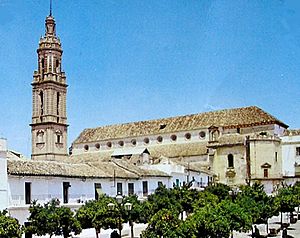Nuestra Señora de la Asunción, Bujalance facts for kids
Nuestra Señora de la Asunción is a beautiful Roman Catholic church located in Bujalance, a town in southern Spain. People also know it as Catedral de la Campina, which means "Cathedral of the Countryside" in Spanish. It is a very old and important building in the region.
Contents
A Look at Its History
This church has a long and interesting past. It started as the church of Santa Maria. This earlier church was built on top of a medieval mosque. This happened after Ferdinand III of Castile conquered the area. The church is also very close to the town's old fortress, called the Alcazaba.
How the Church Was Built
The church shows a mix of different building styles. You can see parts that are Gothic and parts that are Renaissance. Gothic style often has pointed arches and tall windows. Renaissance style focuses on balance and classical shapes.
Famous Architects
Many skilled builders worked on the church. The pointed arches and strong pillars are thought to be designed by famous architects. These include Hernán Ruiz the Elder, Hernán Ruiz the Younger (who worked on it around 1556), and Hernán Ruiz III. The oldest part of the church is its Gothic cross-vault ceiling. This type of ceiling has arches that cross each other to support the roof.
Inside the Church
The inside of Nuestra Señora de la Asunción is just as impressive as its outside. It holds many important artworks and features.
The Main Altar
The main altar, called the high altar, was built in the 16th century. It is a great example of Renaissance art. Experts believe Guillermo de Orta and Andrés de Castillejo created it. The altar also features paintings by Leonardo Enríquez de Navarra.
Special Chapels and Art
Next to the main altar, there is a small chapel. It has a unique hexagonal (six-sided) shape. This chapel was built in the early 18th century and shows the Baroque style. Baroque art is known for being very detailed and dramatic.
Other important artworks in the church include a special case made in the Rococo style. Rococo is a lighter, more decorative style that came after Baroque. A goldsmith from Cordoba named Damián de Castro made this case. You can also see a large painting of the Battle of Lepanto. This was a very important naval battle that happened in 1571. There is also a side entrance made of beautiful pink marble, which is another example of Baroque design.
The Tilting Tower
One of the most noticeable parts of the church is its tall tower. It started being built in 1611. However, it took a very long time to finish, finally completed in 1788. This tower stands 55 meters (about 180 feet) tall. It is sometimes called the "tilting tower" because it leans slightly, much like the famous Leaning Tower of Pisa.
See also
 In Spanish: Iglesia de Nuestra Señora de la Asunción (Bujalance) para niños
In Spanish: Iglesia de Nuestra Señora de la Asunción (Bujalance) para niños


